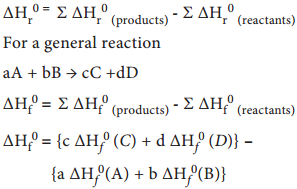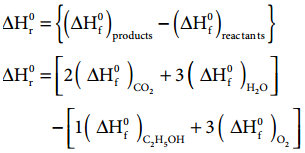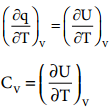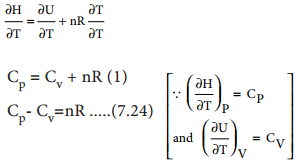Find free online Chemistry Topics covering a broad range of concepts from research institutes around the world.
Thermochemical Equations:
A thermochemical equation is a balanced stoichiometric chemical equation that includes the enthalpy change (ΔH). The following conventions are adopted in thermochemical equations:
1. The coefficients in a balanced thermochemical equation refer to number of moles of reactants and products involved in the reaction.
2. The enthalpy change of the reaction ΔHr has to be specified with appropriate sign and unit.
3. When the chemical reaction is reversed, the value of ΔH is reversed in sign with the same magnitude.
4. The physical states (gas, liquid, aqueous, solid in brackets) of all species are important and must be specified in a thermochemical reaction, since ΔH depends on the physical state of reactants and products.
5. If the thermochemical equation is multiplied throughout by a number, the enthalpy change is also multiplied by the same number.
6. The negative sign of ΔHr indicates that the reaction is exothermic and the positive sign of ΔHr indicates an endothermic reaction.
For example, consider the following reaction,
2H2O(g) → 2 H2O(g) ΔHr° = – 967.4 KJ
2H2O(g) → 2H2(g) + O2(g) ΔHr° = + 967.4 kJ
Standard Enthalpy of Reaction (ΔHr°) from standard enthalpy of formation (ΔHf°)
The standard enthalpy of a reaction is the enthalpy change for a reaction when all the reactants and products are present in their standard states. Standard conditions are denoted by adding the superscript 0 to the symbol (ΔH°)
We can calculate the enthalpy of a reaction under standard conditions from the values of standard enthalpies of formation of various reactants and products. The standard enthalpy of reaction is equal to the difference between standard enthalpy of formation of products and the standard enthalpies of formation of reactants.

Problem 7.2
The standard enthalpies of formation of C2H5OH(l), CO2(g) and H2O(l) are – 277, – 393.5 and – 285.5 kJ mol-1 respectively. Calculate the standard enthalpy change for the reaction
C2H5OH(l) + 3O2(g) → 2CO2(g) + 3 H2O(l)
The enthalpy of formation of O2(g) in the standard state is Zero, by definition
Solution:
For example, the standard enthalpy change for the combustion of ethanol can be calculated from the standard enthalpies of formation of C2H5OH(l), CO2(g) and H2O(l). The standard enthalpies of formation of are – 277, – 393.5 and – 285.5 kJ mol-1 respectively.
C2H5OH(l) + 3O2(g) → 2CO2(g) + 3H2O(l)

ΔHr° = [2 mol (-393.5)kJ mol-1]
[+ 3 mol (0) kJ mol-1
= [- 787 – 856.5] – [- 277]
ΔHr° = – 1366.5 kJ
Heat of Combustion
The heat of combustion of a substance is defined as “The change in enthalpy of a system when one mole of the substance is completely burnt in excess of air or oxygen”. It is denoted by ΔHC. For example, the heat of combustion of methane is – 87.78 kJ mol-1
CH4(g) + 2O2(g) → CO2(g) + 2H2O(l)
ΔHC = – 87.78 kJ mol-1
For the combustion of carbon,
C (s) + O2(g) → CO2(g)
ΔHC = – 394.55 kJ mol-1
Combustion reactions are always exothermic. Hence the enthalpy change is always negative.
Molar Heat Capacities
When heat (q) is supplied to a system, the molecules in the system absorb the heat and hence their kinetic energy increases, which in turn raises the temperature of the system from T1 to T2. This increase (T2 – T1) in temperature is directly proportional to the amount of heat absorbed and inversely proportional to mass of
the substance. In other words,
q α mΔT
q = c m ΔT
c = q/m ΔT
The constant c is called heat capacity.
 …………….. (7.8)
…………….. (7.8)
when m = 1 kg and (T2 – T1) = 1 K then the heat capacity is referred as specific heat capacity. The equation 7.18 becomes
c = q
Thus specific heat capacity of a system is defined as “The heat absorbed by one kilogram of a substance to raise its temperature by one Kelvin at a specified temperature”.
The heat capacity for 1 mole of substance, is called molar heat capacity (cm). It is defined as “The amount of heat absorbed by one mole of the substance to raise its temperature by 1 kelvin”.
Units of Heat Capacity:
The SI unit of molar heat capacity is JK-1mol-1
The molar heat capacities can be expressed either at constant volume (Cv) or at constant pressure (Cp).
According to the first law of thermodynamics
U = q + w or U = q – PdV
q = U + PdV …………….. (7.19)
Differentiate (7.19) with respect to temperature at constant volume i.e dV = 0,
 ……………… (7.20)
……………… (7.20)
Thus the heat capacity at constant volume (CV) is defined as the rate of change of internal energy with respect to temperature at constant volume. Similarly the molar heat capacity at constant pressure (Cp) can be defined as the rate of change of enthalpy with respect to temperature at constant pressure.
CP = (\(\frac{∂H}{∂T}\))p …………. (7.21)
Relation between Cp and Cv for an ideal gas.
From the definition of enthalpy
H = U + PV …………… (7.8)
for 1 mole of an ideal gas
PV = nRT …………… (7.22)
By substituting (7.22) in (7.8)
H = U + nRT …………. (7.23)
Differentiating the above equation with respect to T,

At constant pressure processes, a system has to do work against the surroundings. Hence, the system would require more heat to effect a given temperature rise than at constant volume, so CP p is always greater than Cv.
Calculation of ΔU and ΔH
For one mole of an ideal gas, we have
CV = \(\frac{dU}{dT}\)
dU = CVdT
For a finite change, we have
ΔU = CVΔT
ΔU = CV(T2 – T1)
and for n moles of an ideal gas we get
ΔU = n CV(T2 – T1) …………… (7.25)
Similarly for n moles of an ideal gas we get
ΔH = n CP(T2 – T1) ………….. (7.26)
Problem 7.3
Calculate the value of ΔU and ΔH on heating 128.0 g of oxygen from 0°C to 1000°C. CV and CP on an average are 21 and 29 J mol-1K-1. (The difference is 8Jmol-1 K-1 which is approximately equal to R)
Solution:
We know
ΔU = n CV(T2 – T1)
ΔH = n CP(T2 – T1)
Here n = \(\frac{128}{32}\) = 4 moles;
T2 = 100°C = 373K; T1 = 0° C = 273K
ΔU = n Cv(T2 – T1)
ΔU = 4 × 21 × (373 – 273)
ΔU = 8400 J
ΔU = 8.4 kJ
ΔH = n Cp (T2 – T1)
ΔH = 4 × 29 × (373 – 273)
ΔH = 11600 J
ΔH = 11.6 kJ